Bushnell Equinox Z2 6x50 Night Vision Monocular review
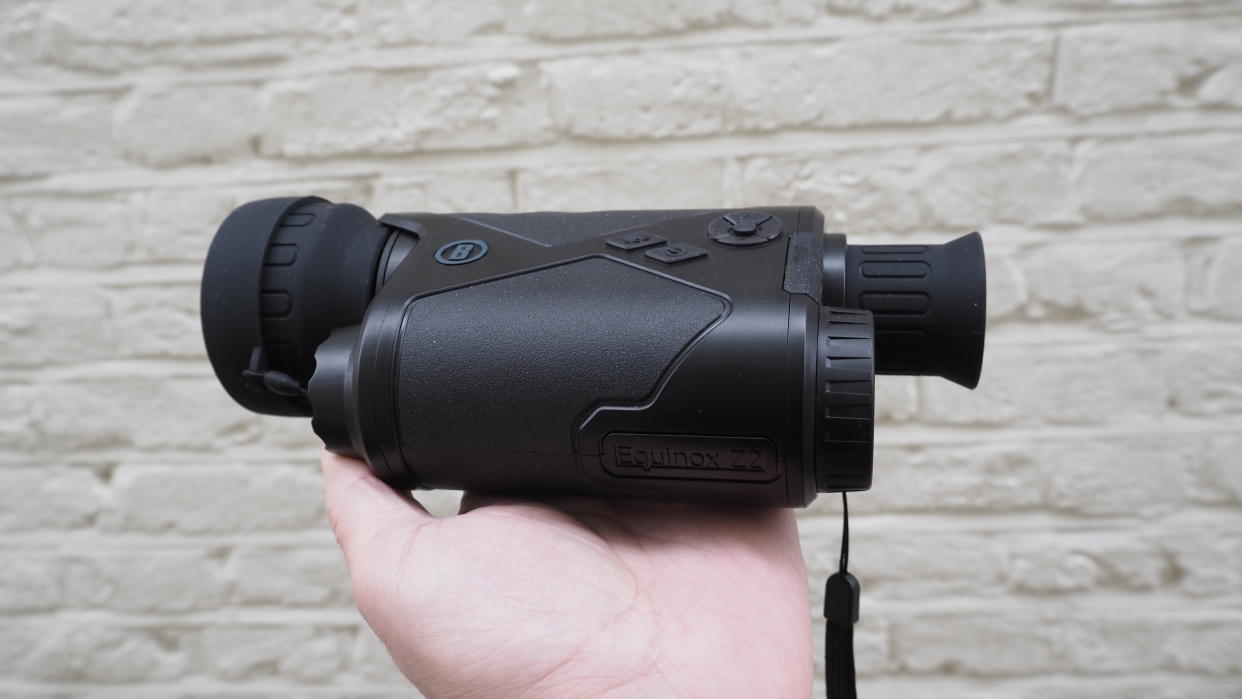
Jump to:
Specifications
Key Features
Design & Handling
Performance
Verdict
Alternatives
I can never eat enough carrots to see as well in the dark as I’d like to. Fortunately then, there are various digital devices that can come to our aid and act as our all-seeing eyes – or singular ‘eye’ in the case of the Bushnell Equinox Z2 6x50 Night Vision Monocular I'm looking at here.
US-based Bushnell’s binoculars and monoculars usually provide more ‘bang’ than Id expect for our buck, so I'd hoping that’s the case again with this one. Upping the ante when compared to its strictly analog counterparts, however, the Equinox Z2 monocular, available in differing magnifications up to 6x unit, seeks to take things to the next level. The claim is that it can enable us to spot targets more than 1,000 feet away whether it’s day or night. Yes, as the full model name suggests, night vision, or at least a version of it, is provided here – with a built-in IR illuminator located just beneath the front lens.
This device also scores points with the gadget obsessive by virtue of being able to potentially stream video footage to our smartphone via a combination of Wi-Fi and the Bushnell Equinox app. Alternatively, if battery life is sufficient, it’s able to record video with audio and stills to an optional microSD card, with support for up to a maximum 64GB capacity, the manual tells us. The card is inserted beneath a rubber flap that also protects a USB port.
While the above all sounds very encouraging in theory, how does use of the device pan out in practice? Is its performance decisive in the dark, or a bit of a night-mare?
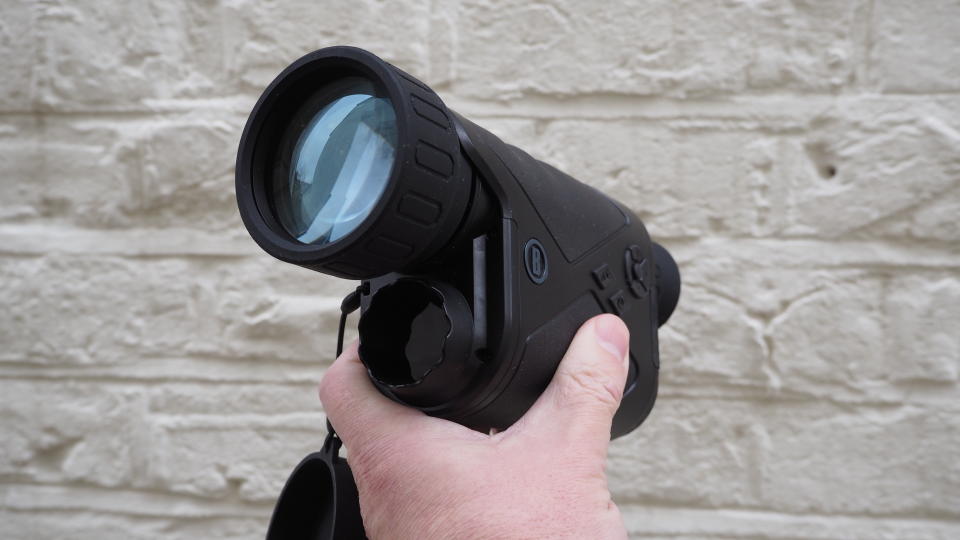
Bushnell Equinox Z2 6x50: Specifications
Bushnell Equinox Z2 6x50: Key Features
As with any strictly analog monocular or binocular, the main features to take note of here are obviously that 6x magnification married to a 50mm objective lens. In order to deliver viewing of subjects up to 1,000ft in the distance, the Bushnell Equinox Z2 6x50 Night Vision Monocular requires four alkaline or rechargeable AA batteries for power, which are not included out of the box.
More unusually still, thanks to a built-in infrared-sensitive CMOS sensor, I can record still images of 8MP resolution and 1080P video with sound, here to a microSD card, which proves typically fiddly to insert and more so to retrieve. Of course, the device will function perfectly well as a live viewer without a card inserted; it’s just that I’ll not be able to record anything, as there’s no internal memory.
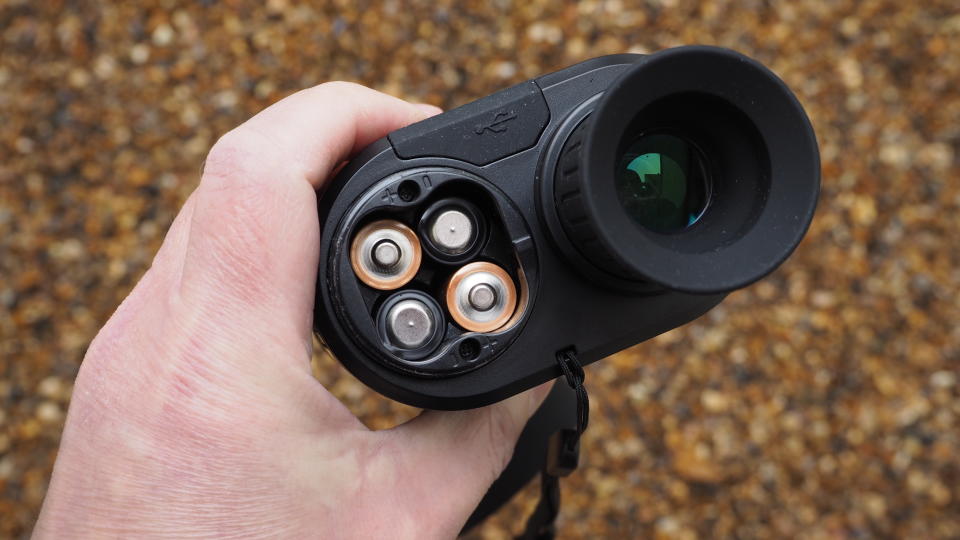
The micro LCD equipped eyepiece provides a digital view of the image in front of its lens, with here that 6x magnification, akin to the sort of quality I'm used to seeing from a security camera, or bootleg VHS video. I can alter the night-time view so I'm either viewing a familiar green image or opt for a black-and-white one.
There’s no separate LCD touchscreen that its camcorder-like design immediately makes us think of, so unless I'm using the compatible Bushnell phone app, all menu selections are made and changes affected via a combination of squinting through the eyepiece/viewfinder and pressing what few controls there are on the outer body of the unit.
Bushnell Equinox Z2 6x50: Design & Handling
The product arrives out of the box with a sturdy zippered carry case, of a thickness and a quality that impresses more than the thin velvety pouches usually supplied with devices of this ilk, plus a standard USB cable. Unsurprisingly there’s no microSD card in the box, so I'll need to supply one of my own.
When held in the palm the Bushnell Equinox Z2 6x50 Night Vision Monocular feels very sturdy and would suit those with larger hands. Soft rubber sections to the bodywork provide purchase points for fingers and thumb when gripped, although personally, I found it a bit of a finger stretch to get a tight hold. The soft rubber surround to the eyepiece is firm but reasonably comfortable when pressed against our eye socket, while the chunky focus ring at the front is of a size comparable to a child’s kaleidoscope. This ring is also encased in the same soft rubber, the 50mm lens it surrounds protected by a spongy slip-on cap of the same material. Said cap arrives pre-tethered to the main body so I'm less likely to lose it in the dark.
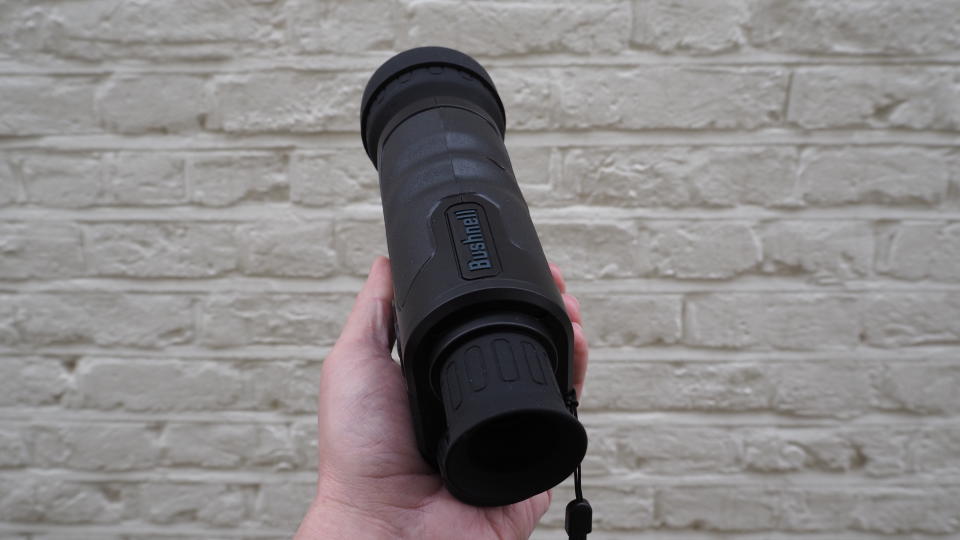
Also arriving pre-tethered is a wrist strap. Although helpful, this is a little on the thin side, especially given the relative bulk and weight of the monocular, so I’d advise replacing the strap with something broader and more comfortable if using the product for prolonged periods. That said, Bushnell has provided a screw thread here, so the monocular could be mounted on a travel tripod for extra stability and comfort should I wish, which would also act as a way of counteracting the blurring effects of hand wobble.
Directly beneath the lens is a very large infrared illuminator, for which the intensity can be manually adjusted via the eyepiece’s internal LCD screen. And at the rear adjacent to the eyepiece is a further dial that I initially mistook for a focus control, but is actually a screw-on cap for the battery compartment. As mentioned, four full-size AA batteries are required for power, which adds weight and bulk. These have to be inserted noting the polarity marks inside the main compartment, marks that are repeated on the circular lid, so I need to line these two elements up before screwing the lid firmly back into place.

A rubberized lozenge-shaped power on/off button and separate record button feature next to each other on the external body of the device, where they naturally fall under the middle fingers of the hand when gripped. Falling under the forefinger meanwhile is a multi-directional control pad/keypad with an unmarked select button in its center that will be immediately familiar to anyone who has previously encountered a similar four-way pad on a digital camera. Use therefore is reasonably intuitive from the off, though I did benefit from a downloadable PDF of the manual which can be found online, as no hard copy was included in the box with our review sample.
Going further as regards operation, and which may appeal if I'm intending this device as a remote viewer, there’s Bushnell’s downloadable, Bushnell Equinox software app. Theoretically, this not only lets us stream video from the monocular to our smartphone, but also controls video recording, image capture, and IR brightness, without having to directly get hands-on and fiddle around with making such adjustments via the in-eyepiece menu. Though functional, we never felt the latter was particularly slick or satisfactory.
Bushnell Equinox Z2 6x50: Performance
Because of the need to house 4xAA batteries which can be either standard alkaline or rechargeable, a memory card, USB port, plus its CMOS image sensor and hardware, the Bushnell Equinox Z2 6x50 Night Vision monocular is by necessity more bulky and clunky in appearance than a standard analogue monocular. It’s certainly more practical than pretty.
When used as a daytime viewer, the image relayed via the eyepiece isn’t anywhere near as sharp as a dedicated analog monocular or binocular would provide, at a third of the price. In brighter outdoor conditions the manual even advises keeping the lens cap on and allowing a very small pinhole in the center of the cap to act as the means via which light is allowed in to enter the lens and strike the sensor. Here it feels like I am watching a low-ish resolution video relay, of the kind of quality we might expect of a security camera. It’s also not that adept at being able to find focus through glass – if I'm indoors on an inclement day but want a better view of exterior subjects for example.
Because the image relayed to our eye is so low resolution, bathed in that eerie green infrared-attributed glow beloved of horror and sci-fi movies or alternatively in less distracting black and white – switchable via the screen menu – it’s very hard to be sure I've found critical focus when out and about in the dark. This means the process of zeroing in on potential subjects for observation is slower and more painstaking than it feels like it should be. It’s also tricky to handhold the device steady enough for a completely wobble-free view or blur-free image capture, though of course a screw thread for a tripod is provided if I want to go to that much trouble.
At times I found my own eyes could see our subject clearer than I could looking through the eyepiece – although as I live in more of an urban area, street lighting can be a distraction. The default image capture resolution is 8 megapixels, though the results I got from video clips were more forgiving in terms of the device’s limitations, which are more readily apparent when reviewing still images.

For those looking to be completely surreptitious when observing skittish subjects in the dark, be aware the glow from the eyepiece’s LCD screen is visible when I'm using the device in complete darkness, and during those moments when it isn’t pressed up squarely against our eye socket. Additionally, there is a faint glow from the infrared illuminator at the front when the device is switched on and active, though not distractingly so and the intensity can be adjusted as desired.
I found however that the device’s rudimentary on-board menu system is rather clunky, finding it awkward to tab through and make selections, as this has to be done with our eye up against the eyepiece and our fingers fumbling for the correct controls, in lieu of any separate LCD screen like I'd find on a camcorder or digital camera. I had to keep checking I was pressing the record button rather than the power on/off button, as both are of the same size and shape and located right next to each other. Placing the power button somewhere else or simply making it a different shape would have helped avoid confusion in the dark.
Another minor grumble is that the device eats up batteries, especially when it’s cold outside. After using the device for 15 or 20 minutes at night with a fully charged set of AAs I started getting a low battery warning. And when the battery is low the monocular will refuse to allow stills or video to be captured, despite having plenty of available microSD card capacity.
Bushnell Equinox Z2 6x50: Verdict
Those seeking a cost-effective way to observe faraway subjects better whether it’s day or night – and specifically when it’s night – will find the offer made by the Bushnell Equinox Z2 6x50 Night Vision monocular a compelling one; on paper at least. However in practice, this needs to be set against the fact that I'm paying a cost premium for the privilege, the device itself is chunky in a camcorder-like way and a standard analog monocular or binocular will provide clearer and sharper views in the daytime, albeit without the ability to simultaneously capture a grainy still photograph or slightly more forgiving video clip with sound to microSD, as is provided here.
With the low-ish resolution view provided via the eyepiece’s mini LCD screen making it very tricky to find critical focus when seeking out subjects at a distance and in the dark, what I'm getting here is basically night vision on a budget. If that suits your specific needs and wallet then this one could be worth seeking out.
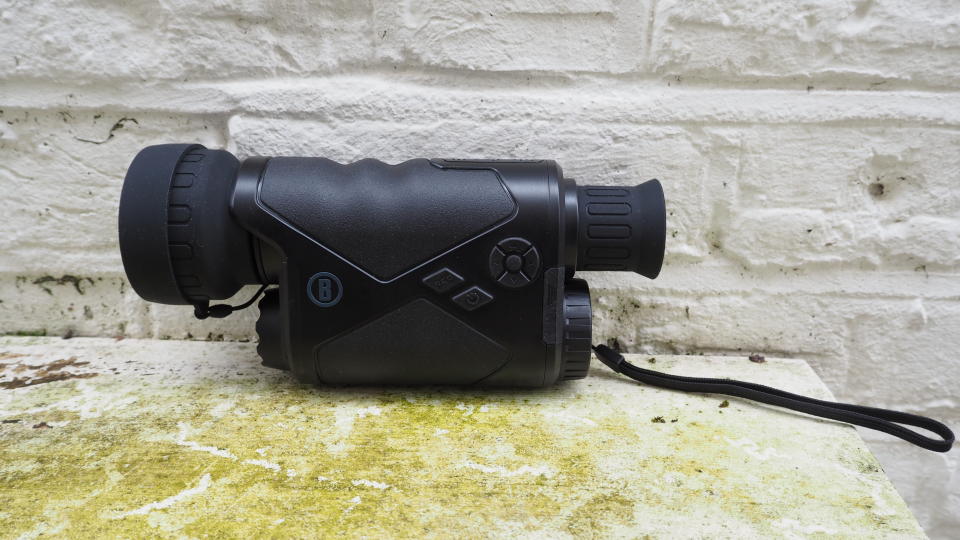
Bushnell Equinox Z2 6x50: Alternatives
While the Bushnell Equinox Z2 6x50 Night Vision monocular is more adequate than perfect, it is reasonably priced compared with competitors. However, there is a broad range of alternatives, where I could find a better fit for our particular needs and budget. For example, there’s the NightFox Corsac binocular, which also provides us with infrared-powered night vision and HD quality video capture to SD card via its CMOS sensor, yet only manages a puny 3x magnification. However, I found that good results are achievable up to 150 meters and fair results at 180 meters, with its bright/fast f/1.4 aperture lens being a further boon.
Budget-priced night vision is alternatively offered by the SigWeis Nightvision, boasting 4x magnification and a viewing distance of 300ft; however, like the NightFox Corsac 6xAA batteries are required for power, giving up to three hours’ usage but adding to the weight at 1.3Kg and bulk. It does however record Full HD resolution in either night vision or colour and the built-in EVF is easy to use.
Or go for a more recognizable name with the Canon PowerShot Zoom Monocular. Though its 3x magnification may seem a little underpowered on paper, the portably pocket-sized device features a 12.1 megapixel 1/3-inch CMOS sensor, ensuring image quality is a cut above cut-priced competitors. However it doesn’t feature night vision and its battery life is fairly modest at a quoted one hour, or 150 shots.

